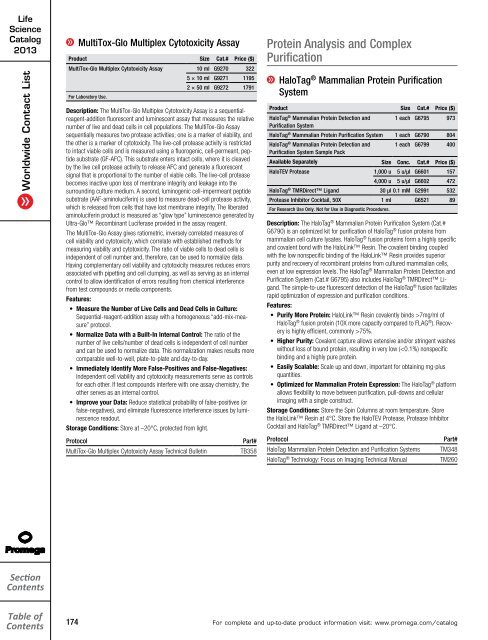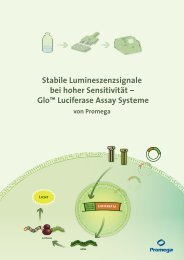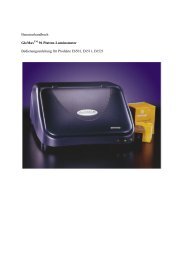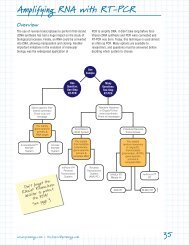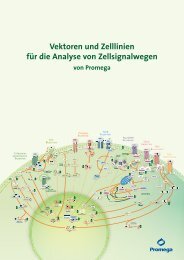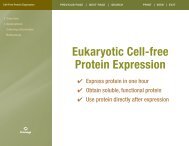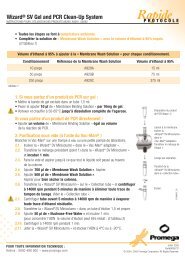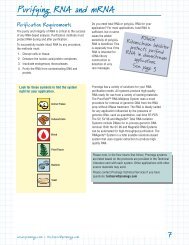2013 Promega catalogue
2013 Promega catalogue
2013 Promega catalogue
Create successful ePaper yourself
Turn your PDF publications into a flip-book with our unique Google optimized e-Paper software.
Life<br />
Science<br />
Catalog<br />
<strong>2013</strong><br />
Worldwide Contact List<br />
Cell Signaling<br />
MultiTox-Glo Multiplex Cytotoxicity Assay<br />
Product Size Cat.# Price ($)<br />
MultiTox-Glo Multiplex Cytotoxicity Assay 10 ml G9270 322<br />
For Laboratory Use.<br />
5 × 10 ml G9271 1195<br />
2 × 50 ml G9272 1791<br />
Description: The MultiTox-Glo Multiplex Cytotoxicity Assay is a sequentialreagent-addition<br />
fluorescent and luminescent assay that measures the relative<br />
number of live and dead cells in cell populations. The MultiTox-Glo Assay<br />
sequentially measures two protease activities; one is a marker of viability, and<br />
the other is a marker of cytotoxicity. The live-cell protease activity is restricted<br />
to intact viable cells and is measured using a fluorogenic, cell-permeant, peptide<br />
substrate (GF-AFC). This substrate enters intact cells, where it is cleaved<br />
by the live cell protease activity to release AFC and generate a fluorescent<br />
signal that is proportional to the number of viable cells. The live-cell protease<br />
becomes inactive upon loss of membrane integrity and leakage into the<br />
surrounding culture medium. A second, luminogenic cell-impermeant peptide<br />
substrate (AAF-aminoluciferin) is used to measure dead-cell protease activity,<br />
which is released from cells that have lost membrane integrity. The liberated<br />
aminoluciferin product is measured as “glow type” luminescence generated by<br />
Ultra-Glo Recombinant Luciferase provided in the assay reagent.<br />
The MultiTox-Glo Assay gives ratiometric, inversely correlated measures of<br />
cell viability and cytotoxicity, which correlate with established methods for<br />
measuring viability and cytotoxicity. The ratio of viable cells to dead cells is<br />
independent of cell number and, therefore, can be used to normalize data.<br />
Having complementary cell viability and cytotoxicity measures reduces errors<br />
associated with pipetting and cell clumping, as well as serving as an internal<br />
control to allow identification of errors resulting from chemical interference<br />
from test compounds or media components.<br />
Features:<br />
• Measure the Number of Live Cells and Dead Cells in Culture:<br />
Sequential-reagent-addition assay with a homogeneous “add-mix-measure”<br />
protocol.<br />
• Normalize Data with a Built-In Internal Control: The ratio of the<br />
number of live cells/number of dead cells is independent of cell number<br />
and can be used to normalize data. This normalization makes results more<br />
comparable well-to-well, plate-to-plate and day-to-day.<br />
• Immediately Identify More False-Positives and False-Negatives:<br />
Independent cell viability and cytotoxicity measurements serve as controls<br />
for each other. If test compounds interfere with one assay chemistry, the<br />
other serves as an internal control.<br />
• Improve your Data: Reduce statistical probability of false-positives (or<br />
false-negatives), and eliminate fluorescence interference issues by luminescence<br />
readout.<br />
Storage Conditions: Store at –20°C, protected from light.<br />
Protocol<br />
MultiTox-Glo Multiplex Cytotoxicity Assay Technical Bulletin<br />
Part#<br />
TB358<br />
Protein Analysis and Complex<br />
Purification<br />
HaloTag ® Mammalian Protein Purification<br />
System<br />
Product Size Cat.# Price ($)<br />
HaloTag ® Mammalian Protein Detection and 1 each G6795 973<br />
Purification System<br />
HaloTag ® Mammalian Protein Purification System 1 each G6790 804<br />
HaloTag ® Mammalian Protein Detection and 1 each G6799 400<br />
Purification System Sample Pack<br />
Available Separately Size Conc. Cat.# Price ($)<br />
HaloTEV Protease 1,000 u 5 u/µl G6601 157<br />
4,000 u 5 u/µl G6602 472<br />
HaloTag ® TMRDirect Ligand 30 μl 0.1 mM G2991 532<br />
Protease Inhibitor Cocktail, 50X 1 ml G6521 89<br />
For Research Use Only. Not for Use in Diagnostic Procedures.<br />
Description: The HaloTag ® Mammalian Protein Purification System (Cat.#<br />
G6790) is an optimized kit for purification of HaloTag ® fusion proteins from<br />
mammalian cell culture lysates. HaloTag ® fusion proteins form a highly specific<br />
and covalent bond with the HaloLink Resin. The covalent binding coupled<br />
with the low nonspecific binding of the HaloLink Resin provides superior<br />
purity and recovery of recombinant proteins from cultured mammalian cells,<br />
even at low expression levels. The HaloTag ® Mammalian Protein Detection and<br />
Purification System (Cat.# G6795) also includes HaloTag ® TMRDirect Ligand.<br />
The simple-to-use fluorescent detection of the HaloTag ® fusion facilitates<br />
rapid optimization of expression and purification conditions.<br />
Features:<br />
• Purify More Protein: HaloLink Resin covalently binds >7mg/ml of<br />
HaloTag ® fusion protein (10X more capacity compared to FLAG ® ). Recovery<br />
is highly efficient, commonly >75%.<br />
• Higher Purity: Covalent capture allows extensive and/or stringent washes<br />
without loss of bound protein, resulting in very low (


